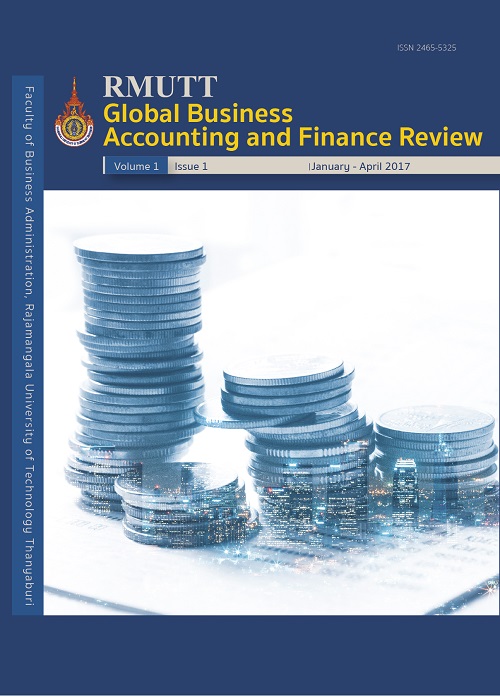Behavioral Finance Factors and Investment Decision on Thai Mutual Fund
Keywords:
Mutual Fund, Behavioral Finance, Self-control Bias, Overconfidence Bias, Loss Aversion Bias, Mental Accounting Bias, Degree of Risk AversionAbstract
Thai mutual funds have grown rapidly for the past decade. This research intends to study investment decision making of Thai mutual fund investors. Behavior finance concepts, including self-control bias, overconfidence bias, loss aversion bias, mental accounting bias, and degree of risk aversion, are employed in determine decision on investing in mutual fund. Experimental survey research is conducted by using self-reported questionnaire from 600 Thai investors. Multivariate Probit models are employed in analyzing the investment decision of respondents on top three Thai mutual funds. Estimated results indicate that behavior finance factors have significantly impacts on investment decision of investors. Additionally, perception on asset management companies of the mutual fund plays an important role in determining investment decision of respondents. Therefore, asset management companies should focus on their mutual fund performance and also building up their company image in order to motivate investors to invest in their mutual fund.
References
Black, F. (1964). Noise. Journal of Finance, Vol. 41, pp. 529–543.
Chavas, J.P. (2004). Risk Analysis in Theory and Practice. Elsevier Academic Press, pp. 31-51.
De Long, J., Shleifer, A., Summers, L., & Waldman, R. (1990). Noise trader risk in financial markets. Journal of Political Economy, Vol. 98, pp. 703–738.
Duflo, E. & Saez, E. (2002). Participation and investment decisions in a retirement plan: The influence of colleagues’ choices. Journal of Public Economics, Vol. 85, pp. 121-148.
Farmer, J. & Joshi, S. (2002). The price dynamics of common strategies. Journal of Economic Behavior and Organization, Vol. 49, pp. 149–171.
Frijns, B., Koellen, E. & Lehnert, T. (2008). On the determinants of portfolio choice. Journal of Economic Behavior and Organization, Vol. 66, pp. 373-386.
Kahneman, D. & Tversky, A. (1979). Prospect theory: An analysis of decision under risk. Econometrica, Vol. 47, pp. 263-91.
Markowitz, H. (1952). Portfolio selection. Journal of Finance, Vol. 7, pp. 77–92.
Mitchell, O.S. & Utkus, S.P. (2006). How behavioral finance can inform retirement plan design. Journal of Applied Corporate Finance, Vol. 18, no. 1, pp. 82-95.
Modigliani, F. & Brumberg, R. (1954). Utility analysis and the consumption function. In Post-Keynesian Economics, Edited by K. Kurihara. Rutgers University Press, New Brunswick, NJ. pp. 338–436.
Odean, T. (1998). Are investors reluctant to realize their losses? Journal of Finance, Vol. 53, pp. 1775–1779.
Pompian, M.M. (2012). Behavioral Finance and Wealth Management: How to Build Optimal Portfolios that Account for Investor Biases, 2nd ed., John Wiley & Son, Hoboken, NJ.
Sharpe, W.H. (1964). Capital asset prices: A theory of market equilibrium under conditions of risk. Journal of Finance, Vol. 19, pp. 425-442.
Thaler, R. & Benartzi, S. (2004). Saving more tomorrowTM: Using behavioral economics to increase employee saving. Journal of Political Economy, Vol. 112, no. 1, pp. 167-87.
Thaler, R. & Richard, H. (1990). Anomalies: Saving, fungibility, and mental accounts. Journal of Economic Perspectives, Vol. 4, no. 1, pp. 193-205.









